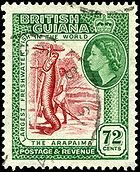 The Arapaima is a tropical fish of the Amazon basin. It is one of the largest freshwater fish in the world. Arapaima reach sizes of up to 15 feet in length. The scales are olive-green, turning increasingly reddish towards the tail region.
The Arapaima is a tropical fish of the Amazon basin. It is one of the largest freshwater fish in the world. Arapaima reach sizes of up to 15 feet in length. The scales are olive-green, turning increasingly reddish towards the tail region.The swim bladder is open to the pharynx and the arapaima uses the bladder which is rich in blood vessels as a lung. Arapaima feed mainly on fish.
Anatomy and morphology
Arapaima can reach lengths of more than 2 m (6.6 ft), in some exceptional cases even more than 2.5 m (8.2 ft) and over 100 kg (220 lbs). The often cited maximum length of 4.5 m (14.8 ft)[2][3] comes from a single second-hand-report from the first half of the nineteenth century, and is not confirmed.[citation needed] The maximum-cited weight for the species is 200 kg (440 lbs). As one of the most sought after food fish species in South America, it is often captured primarily by handheld nets for export, by spearfishing for local consumption, and, consequently, large arapaima of more than 2 m are seldom found in the wild today.Ecology
The diet of the arapaima consists of fish, crustaceans, and other small animals. The fish is an air-breather, using its swim bladder, which is rich in blood vessels and opens into the fish's mouth,[4] an advantage in oxygen-deprived water that is often found in the Amazon River. This fish is therefore able to survive in shallow waters with dissolved oxygen as low as 0.5 ppm.Reproduction
Due to the geographic range that arapaima inhabit, the animal's life cycle is greatly affected by the seasonal flooding that occurs. The arapaima lays its eggs during the months of February, March, and April when the water levels are low or beginning to rise. They build a nest approximately 50 cm wide and 15 cm deep, usually in muddy bottomed areas. As the water rises the eggs hatch and the offspring have the flood season to prosper, during the months of May to August. Therefore, the yearly spawning is regulated seasonally. The arapaima male is supposed to be a mouthbrooder, like its relative the Osteoglossum spp., meaning the young are protected in its mouth until they are older. The female arapaima helps to protect the male and the young by circling them and fending off potential predators.
In his book The Whispering Land, naturalist Gerald Durrell reports hearing the tale in Argentina that female arapaima have been seen secreting a white substance from a gland in the head and that their young have been noted seemingly feeding on the substanceImportance to humans
 The arapaima is hunted and utilized in many ways by local human populations. Arapaima are harpooned or caught in large nets and the meat is said to be delicious. Since the arapaima needs to swim up to breathe air, traditional arapaima fishers often catch them by first harpooning them and then clubbing them dead. One individual can yield as much as 70 kg of meat.
The arapaima is hunted and utilized in many ways by local human populations. Arapaima are harpooned or caught in large nets and the meat is said to be delicious. Since the arapaima needs to swim up to breathe air, traditional arapaima fishers often catch them by first harpooning them and then clubbing them dead. One individual can yield as much as 70 kg of meat.
The arapaima has also been introduced for fishing in Thailand and Malaysia. Fishing for this species in Thailand can be done in several lakes, where it is not uncommon to see arapaima over 150 kg landed and then released.
Special care is needed when dealing with these fish as although they are large they are also hard to deal with, with catch and release after the fish is landed it must be held in a shallow pen/bed for about 3 hours, as this species goes into shock so a careful watch must be kept to make sure that it is coming up for air about every 15 min, if not then the fish can be gently lifted so that its head comes out of the water, when this happens they have a reflex action to breathe. Arapaimas are also known to leap out of the water if they feel constrained by their environment or harassed.
It is also considered an aquarium fish, although it obviously requires a large tank and ample resources. This animal also appears in the pet trade, although to keep an arapaima correctly requires a large tank and can prove quite difficult.
The tongue of this fish is thought to have medicinal qualities in South America. It is dried and combined with guarana bark, which is grated and mixed into water. Doses of this are given to kill intestinal worms. In addition, the arapaima's bony tongue is often used to scrape cylinders of dried guarana, an ingredient in some beverages, and the bony scales are used as nail files.
In July 2009, some villagers who live around Kenyir Lake in Terangganu, Malaysia reported sighting the arapaima gigas. The "Kenyir Monster" or "dragon fish" as the locals call it, is claimed to be responsible for the mysterious drowning of two men on June 17In popular culture
- In the Nintendo GameCube videogame Animal Crossing and subsequent sequels, the Arapaima is one of the rarest catches.
- In the PC game The Amazon Trail II the Arapaima (called Pirarucu in the game) sometimes appears while spearfishing it is one of the largest fish in the game, and only appears once in any one fishing session.
- The Arapaima can also be found in the Nokia NGage title Hooked On: Creatures of the Deep at the games Thailand resort Top Cats
- In the Street Fighter II games, a large Arapaima is seen hanging in the background of Blanka's stage in Brazil, along with an anaconda and the Amazon River.
- In the Petz games on Wii & PS2 Catz & Dogz 2, the Arapaima is found in Gongoro Peak.There is also a Golden Arapaima, which is one of the rarest catches.
- The New England Aquarium has a large exhibit on Arapaima gigas.
- Sri Lanka's Zoological Gardens Located in Dehiwala also has several specimens listed as 'The World's largest freshwater fish'.
Image of Arapaima







Video of Arapaima
Source : The Jump, Wikipedia.org, Carpecarpio.com

Tidak ada komentar:
Posting Komentar